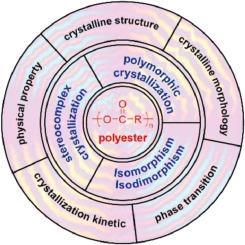Progress in Polymer Science ( IF 26.0 ) Pub Date : 2020-08-21 , DOI: 10.1016/j.progpolymsci.2020.101291 Ying Zheng , Pengju Pan

|
In the past two decades, synthetic biodegradable and biobased polyesters have emerged as a sustainable alternative to traditional petroleum-derived polymers for diverse range of applications. Most of the synthetic biodegradable and biobased polyesters are semicrystalline. Some of these polymers can exist in a variety of polymorphs depending on the crystallization or processing conditions. In addition, blends or copolymers can exhibit cocrystallization behavior (such as stereocomplex, isomorphic, and isodimorphic crystallization). Polymorphic crystallization and cocrystallization of polymers plays an essential role not only in the scientific understanding of condensed matter structures of polymers, but also in the technological development and application of this new class of materials. This paper reviews the recent progress in the understanding of the polymorphic crystallization, co-crystallization, and structure-property relationships of synthetic biodegradable and biobased polyesters that has occurred within the past decade. Particular focus is on the structure, morphology, formation kinetics, and phase transition of crystals grown from biodegradable and biobased polyesters. Since the physical properties of polymers depend on their crystal structure and morphology, we also reviewed the relationships between the crystallization or processing conditions, crystalline structure and morphology, and physical properties (e.g., mechanical and biodegradability) of biodegradable and biobased polymorphic, cocrystallizable polyesters.
中文翻译:

可生物降解和生物基聚酯的结晶:多晶型结晶,共结晶和结构性质关系
在过去的二十年中,合成生物可降解聚酯和生物基聚酯已经成为可替代传统石油衍生聚合物的可持续选择,可用于多种应用。大多数合成的可生物降解和生物基聚酯是半结晶的。这些聚合物中的一些可以根据结晶或加工条件以多种多晶型物存在。另外,共混物或共聚物可表现出共结晶行为(例如立体络合物,同晶和同晶)。聚合物的多晶型结晶和共结晶不仅在科学上理解聚合物的凝聚态结构方面,而且在这种新型材料的技术开发和应用中都起着至关重要的作用。本文回顾了近十年来对合成的可生物降解和生物基聚酯的多晶型结晶,共结晶和结构-性质关系的理解的最新进展。特别关注的是由可生物降解和生物基聚酯制成的晶体的结构,形态,形成动力学和相变。由于聚合物的物理性质取决于其晶体结构和形态,因此我们还回顾了结晶或加工条件,晶体结构和形态与物理性质之间的关系(特别关注的是由可生物降解和基于生物的聚酯生长的晶体的结构,形态,形成动力学和相变。由于聚合物的物理性质取决于其晶体结构和形态,因此我们还回顾了结晶或加工条件,晶体结构和形态与物理性质之间的关系(特别关注的是由可生物降解和生物基聚酯制成的晶体的结构,形态,形成动力学和相变。由于聚合物的物理性质取决于其晶体结构和形态,因此我们还回顾了结晶或加工条件,晶体结构和形态与物理性质之间的关系((例如机械和生物降解性)可生物降解和生物基多晶型可共结晶聚酯。











































 京公网安备 11010802027423号
京公网安备 11010802027423号